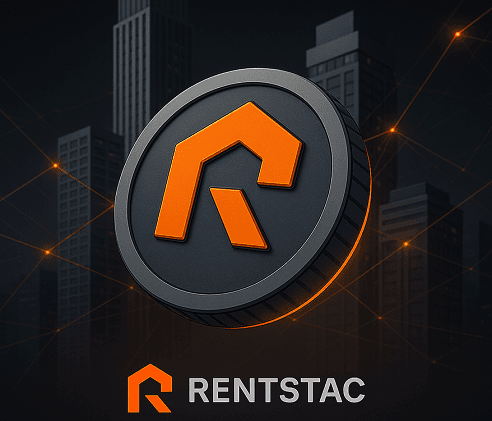Rentstac (RNS): Analysts See a 100x Opportunity as Tokenized Real Estate Redefines DeFi in 2026

In a market overflowing with speculation and short-lived hype, Rentstac (RNS) has quietly emerged as one of the most substantial and credible crypto presales of the upcoming cycle.
After more than a year of development, the project has entered Phase 1 of its live presale, offering RNS tokens at just $0.025. For many analysts, this represents a rare early-stage opportunity to join a protocol that bridges real-world assets (RWA) with decentralized finance — and does it with precision, compliance, and purpose.
Unlike projects that rely purely on hype or unproven tokenomics, Rentstac is built around a fully documented, legally structured model that transforms real estate into a tokenized, yield-generating asset class, with every property backed by a Special Purpose Vehicle (SPV) and verified on-chain.
With its combination of smart contract automation, multi-sig security, DAO governance, and real economic yield, analysts now view Rentstac as one of the most promising DeFi initiatives of 2026, with potential returns exceeding 100x from its initial presale price.
Transforming Real Estate into Decentralized Yield
Real estate has always been one of the most stable and profitable asset classes — but also one of the least accessible.
Rentstac changes that equation through blockchain-based tokenization, which divides each property into thousands of RNS tokens, representing fractional ownership and economic rights over rental flows and governance decisions.
The process is not abstract:
Each property is owned by a dedicated SPV (Special Purpose Vehicle) — a legally registered company that ensures investors’ rights are fully recognized.
RNS tokens, therefore, are not merely digital representations of value; they are shares tied to actual income-producing real estate, making Rentstac’s system both legally sound and technologically transparent.
Through this structure, investors can:
- Access a global catalog of verified and certified properties,
- Invest with just a few hundred dollars,
- Receive passive income automatically via smart contracts,
- Resell tokens on Rentstac’s secondary marketplace for liquidity, and
- Participate directly in on-chain governance to shape asset-level decisions.
Rentstac effectively makes real estate as simple and liquid as trading a stock, while preserving the credibility and regulatory foundation of traditional finance.
The Presale: Phase 1 at $0.025 — The Perfect Entry Point
After extensive development and legal structuring, Rentstac’s Presale Phase 1 is now live at $0.025 per RNS — the earliest and most advantageous stage for investors to join.
According to the official tokenomics outlined in the whitepaper, the presale will unfold across seven phases, with progressive price increases that reward early adopters and limit overall dilution.
| Phase | Price | Allocation | Raise per Phase |
| 1 | $0.025 | 240,000,000 RNS | $6,000,000 |
| 2 | $0.030 | 160,000,000 RNS | $4,800,000 |
| 3 | $0.035 | 140,000,000 RNS | $4,900,000 |
| 4 | $0.040 | 100,000,000 RNS | $4,000,000 |
| 5 | $0.045 | 80,000,000 RNS | $3,600,000 |
| 6 | $0.050 | 50,000,000 RNS | $2,500,000 |
| 7 | $0.055 | 30,000,000 RNS | $1,650,000 |
With 40% of total supply (800 million RNS) allocated to presale, Phase 1 offers the largest token availability and lowest price.
Experts estimate that reaching the final presale stage could already imply a 120%–150% price appreciation, even before the official token listing.
The total RNS supply is capped at 2 billion, with no further issuance possible — a detail that supports long-term deflationary value.
Real-World Assets, Real Yield
Rentstac’s value proposition is anchored in one concept: real yield.
Unlike DeFi projects whose returns depend on unsustainable token emissions or speculative staking rewards, Rentstac distributes income from real properties directly to token holders.
Each property generates rent and operational profits that flow through the blockchain and are automatically distributed using smart contracts.
Investors who stake RNS within dedicated property pools receive proportional income, paid directly in RNS tokens, creating a closed economic loop that continually supports token demand.
In addition:
- Part of the rental flows are used for RNS buybacks and burns,
- Smart contracts regulate payouts and property KPIs transparently,
- A DAO oversees decisions such as property manager replacements, asset sales, and yield allocations.
This creates a transparent, self-sustaining ecosystem, where value is constantly recycled and supported by real economic performance — not speculation.
Security, Legal Structure, and Automation
One of Rentstac’s strongest advantages lies in its multi-layered security and compliance architecture, which blends decentralized infrastructure with traditional financial safeguards.
According to the whitepaper, the protocol uses:
- Multi-sig escrow contracts for fund custody,
- Independent oracles for milestone verification,
- Audited smart contracts (CertiK audit in progress),
- Legally registered SPVs for each property, and
- DAO governance for strategic decisions.
Funds collected during the presale are stored in multi-signature wallets and released only when pre-defined milestones are verified by independent oracles — for example, the legal registration of a property or completion of an audit.
This model protects investors from misuse of funds and guarantees operational transparency.
In short, Rentstac combines the security of blockchain with the accountability of regulated finance, setting a new standard for trust in DeFi.
Tokenomics and Allocation
Rentstac’s economic model is engineered for stability and value creation.
The 2 billion RNS supply is distributed as follows:
| Category | Allocation | Tokens | Purpose |
| Presale | 40% | 800,000,000 | Public distribution (7 phases) |
| Liquidity & Reserves | 20% | 400,000,000 | Exchange liquidity & treasury |
| Team & Founders | 15% | 300,000,000 | Long-term development |
| Community Rewards | 10% | 200,000,000 | Staking, referrals, governance |
| Marketing & Partnerships | 8% | 160,000,000 | Global expansion |
| Development Fund | 4% | 80,000,000 | Audits & upgrades |
| Legal & Compliance | 3% | 60,000,000 | Multi-jurisdiction operations |
The model also includes deflationary mechanisms such as buybacks and burns financed by property flows — ensuring that token scarcity increases over time as the ecosystem expands.
How Rentstac Works: From Tokenization to DAO Control
Each new property integrated into the Rentstac ecosystem follows a multi-step process:
- Due Diligence & Selection
Properties are screened based on profitability, geographic stability, and construction quality.
Legal and technical due diligence ensure that each asset meets protocol standards. - SPV Creation
Each property is legally encapsulated within a Special Purpose Vehicle, isolating ownership and flows.
Investors acquire tokens that correspond to SPV shares, ensuring traceability. - Pool Opening
A pool is created for each property, allowing investors to allocate their RNS and earn proportional returns.
Non-stakers still benefit indirectly from buybacks and deflationary supply. - On-Chain Monitoring
Property KPIs — such as occupancy, maintenance costs, and net yield — are tracked via oracles and shown on the Rentstac dashboard in real time. - DAO Governance
Once operational, the DAO votes on key actions: property manager changes, buyback ratios, and reinvestment strategies.
Through this structure, Rentstac enables community-driven management of real assets — something that was unthinkable in traditional finance.
Protocol Stability and Safeguards
The Rentstac whitepaper dedicates significant focus to stability — a word often absent from DeFi vocabulary.
Several mechanisms ensure resilience and investor protection:
- Escrow-based fund release — capital is unlocked only after verified milestones.
- Independent oracles validate asset valuations and yield distributions.
- Regular audits maintain security and transparency.
- Liquidity pool locks prevent manipulation and rug pulls.
- Binding DAO governance guarantees community control over core decisions.
- Anti-inflation measures like token burns and real-flow buybacks sustain long-term balance.
In essence, every line of code, contract, and policy is designed to make Rentstac as secure and predictable as a traditional investment — but decentralized.

Liquidity and Market Resilience
While real estate is historically illiquid, Rentstac’s architecture changes that paradigm.
Through its internal secondary marketplace and liquidity pools, investors can buy and sell property-backed tokens instantly — achieving what traditional real estate could never offer: immediate liquidity.
Liquidity providers are rewarded with RNS incentives and transaction fees, encouraging constant participation.
Meanwhile, the platform’s buyback policies ensure consistent demand, reducing volatility and supporting price stability even in uncertain market conditions.
Stable Yield and Risk Mitigation
Rentstac’s stable yield model uses real property income — rent, leasing fees, or capital gains — to create steady returns for investors.
Yields are distributed programmatically to stakers through smart contracts, primarily in RNS, aligning token utility with value generation.
Meanwhile, simple holders (non-stakers) still benefit from buyback and burn events, which indirectly increase token value over time.
The project also implements a reserve fund and asset diversification across residential, commercial, and green infrastructures to protect against market-specific risks.
This hybrid structure — part DeFi, part institutional-grade finance — gives Rentstac the resilience that many crypto projects lack.
Roadmap: From Foundation to Global Expansion
Phase 1 – Foundation (2025)
- Presale launch (Phase 1 live at $0.025)
- Smart contract deployment on Ethereum
- CertiK audit (in progress)
- Early partnerships with real estate issuers and managers
Phase 2 – Property Integration (Q1–Q2 2026)
- Establishment of first SPVs and property pools
- Launch of investor dashboard and KPIs monitoring
- DAO activation for community-driven decisions
Phase 3 – Marketplace & Liquidity (Q3–Q4 2026)
- Launch of Rentstac secondary marketplace
- Multi-chain expansion (Polygon, BNB Chain)
- Listings on major exchanges
- Start of institutional onboarding and cross-border partnerships
Phase 4 – Global Growth (2027 and beyond)
- 500+ tokenized properties under management
- Integration of AI-based property valuation
- Legal expansion across Europe, LATAM, and Asia-Pacific
Rentstac’s development plan is ambitious yet grounded in realism — with every milestone measurable, verifiable, and traceable on-chain.
Why Analysts Are Bullish on RNS
Analysts covering DeFi and RWA sectors are consistently optimistic about Rentstac’s trajectory.
They highlight the project’s combination of institutional infrastructure, legal compliance, and community-driven design as its biggest competitive advantage.
According to CryptoMarket Review:
“Rentstac is what DeFi 2.0 was supposed to become — a system that merges blockchain efficiency with real-world profitability. It’s not just a presale; it’s the foundation of a new asset class.”
In a time when investors are increasingly skeptical of speculative narratives, Rentstac’s model of “real assets, real yield, real governance” provides something the market desperately needs — credibility.
Conclusion: The Best of Both Worlds
Rentstac (RNS) is more than a token — it’s the embodiment of a new financial paradigm where property meets protocol.
By combining real estate’s stability with DeFi’s accessibility, the project delivers what both worlds have lacked: liquidity for the physical, and legitimacy for the digital.
With smart contracts already live, CertiK audits underway, and Phase 1 of the presale active at just $0.025, Rentstac stands out as one of the most concrete investment opportunities of the coming cycle.
For early investors, this could be the moment to join a movement that turns real-world ownership into programmable yield, and RNS could be the token that leads that transformation.
Learn more and join the presale at rentstac.com


